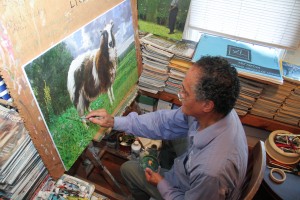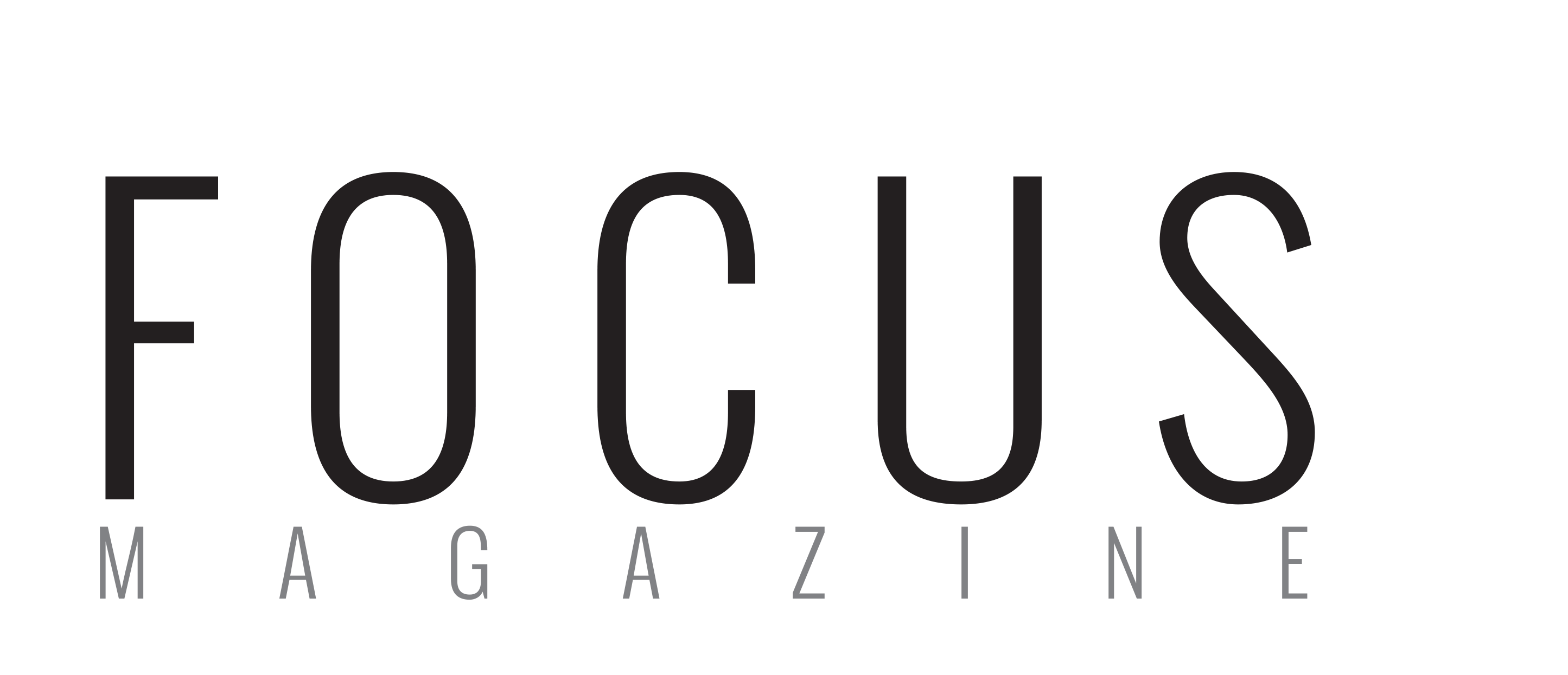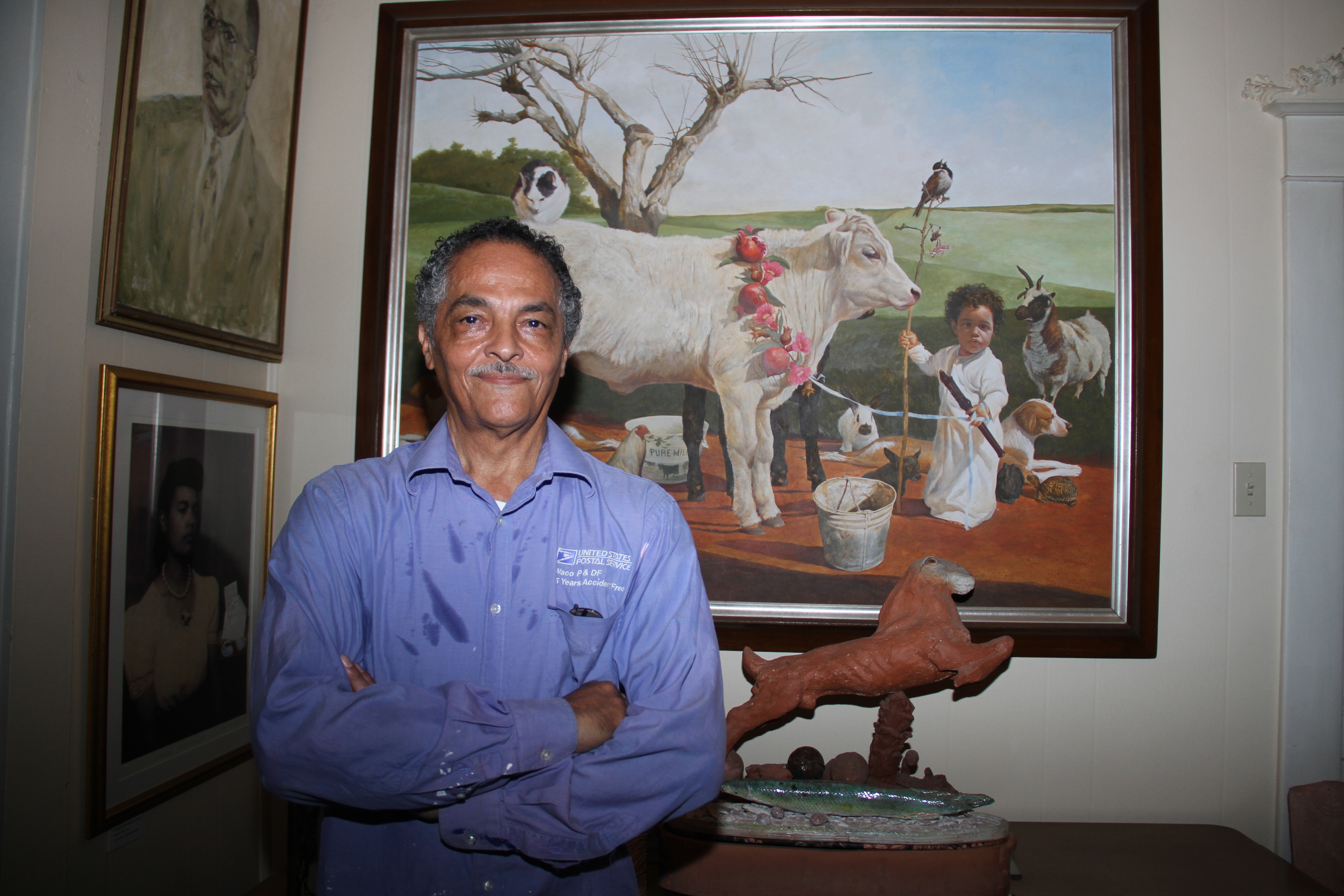Stacks of National Geographic copies sit in front of the window as light pours through, illuminating the smallest brush strokes on a piece of white Canson paper. His glasses rest on the bridge of his nose and his curly black hair glistens in the light. If looking closely, paint stains decorate his blue button-down shirt and a U.S. Postal Service patch adorns the front.
The scene of this seemingly disheveled, yet organized and serene studio in East Waco is home to the only American scarf designer to ever work for the Parisian design house, Hermès. Kermit Oliver is an unlikely candidate for a leading fashion brand designer. He leads a very quiet existence, away from the hustle and bustle of the fashion world, just out of the reach of the public and the art community that appreciates his work so greatly.
“It’s all these events that happen that illuminate something and people respond to it,” Oliver said, “But compared to an artist’s work, it’s very modest. It’s serendipity. You’re there in a place and you can take advantage of it, but a lot of times I don’t.”

A true Texas artist, Oliver designs scarves that are unique in style, bold in color and American-themed, portraying old Western scenes, Native Americans and explorers coming to “les ameriques.” He has worked for Hermès for 30 years now; 30 years which he claims to have been relatively uneventful despite working for one of the premier names in fashion.
Oliver grew up in south Texas and moved to Waco in 1984. His wife, Katie, had family in Waco and had attended Baylor when she was younger. After her grandparents left her their home, the same one she and Oliver still live in, they ended up staying.
“My grandparents lived here. They were both very ill. She wanted me to have her home so we came to live here while she was still alive to help out,” Katie explained. “That was the main reason we came here.”
Despite his bachelor’s degree in fine arts, Oliver never intended to make a career of his work, only showing it when it was sought out. In fact, he said that a career in commercial arts was discouraged when he was in school.
“It’s very modest,” Oliver said. “My art is very ordinary. It wasn’t something urgent that I had to do. It wasn’t something that was primary in my life. It was very down the road. I never went out to promote or engage other people with my art. It was always events that made it happen. With as much restraint as I could, I was able to keep secluded.”
After moving to Waco from Houston, Oliver continued his employment of six years with the U.S. Postal Service and worked for the Waco post office for 30 more years. This has always been his main source of income, enabling him to work freely on his art. He was able to lead a normal life outside of the limelight while working night shifts at the post office.
“My security was never based in my art, so I was able to go out and leisurely do things that I wanted to and any advancement of notoriety came about by happenstance,” he said. “I was just made available every once in a while so it grew out of that. My art was nothing dealing with the art community.”
Oliver is represented by Houston gallery Hooks-Epstein after leaving his previous gallery in Houston, DuBose, because of their insistence of promotion of his work. It was also a driving factor in Oliver’s employment at the post office.
“It was one of the reasons I decided to start at the post office,” he said. “The format had changed with the new owner of the gallery I was with. You had to go out and be more promotional and I had never done that.”
Oliver only has one solo exhibition of his work every two years, keeping out of the public spotlight, but was still able to draw the attention of Hermès during one of his gallery showings in Houston.
“Every two years I have a one-man exhibit. That’s the only time I have an offering of my work,” Oliver said. “Every two years I make a public showing of myself for about three hours and that’s it.”
It just so happened that Hermès contacted him through Hooks-Epstein after Lawrence Marcus, the late son of entrepreneurial giant Neiman Marcus, recommended him for the job of designing scarves for the brand. Marcus, who lived in Dallas at the time, had stopped by one of Oliver’s rare solo exhibitions and fell in love with his work.
“[Hermès was] interested in introducing American themes,” Oliver said. “It would either be the history of Neiman Marcus or the opening of the Forth Worth Weston museum or a choice of my own. Lawrence Marcus had suggested me as an artist. Xavier [Guerrand-Hermès] Dumas came and interviewed me. I decided to do an American Indian theme. That’s where it all began.”
With an idea of what the scarf will look like, Oliver uses photo references to place specific images in a design that will eventually become an ornate and colorful silk scarf. Waco-McLennan County Library on Austin Avenue is his largest source for references, he says, and he spends a good amount of time there selecting images he can use for ideas.
“When they suggest a theme, there are artists working toward it,” he said. “It’s a matter of finding references and putting them together. I know where everything goes; it’s just a matter of finding an object I can put there.”
The designs of the scarves are typically radial, with a dominant focal image in the center and other smaller objects set around it in a circular manner, but others are simply detailed scenes and images set in the silk square. Much like his paintings, Oliver primarily focuses on people in his designs, using objects and patterns to support the figurative nature. Other designs include cornucopias, different Texas wildlife and even the occasional historical figure, such as Marquis de Lafayette.
During his time with Hermès, Oliver has designed 17 scarves for the brand. His first, released in 1982, is called Pani La Shar Pawnee, and his most recent was released in limited quantities in February of this year.
La Vie Sauvage du Texas was designed for the Caesar Kleburg Wildlife Research Institute and some proceeds went to conservation efforts made by the King Ranch, owned by the Kleburg family.
Oliver’s scarves go for about $425 retail, if buyers are quick enough to reserve one since many times they sell out quickly. Used, on eBay, his scarves can range up to $1,000.
Despite his ongoing work and relationship with Hermès, Oliver intends to keep to himself. He even turns down the offer to visit their factories and mingle with the upper echelon of the company in Paris.
“We’ve gone twice and refused 28 times,” Oliver said. “They want us to come every year. It’s been about 30 years working for them. It’s been a quiet 30 years.”
Oliver’s paintings are just as impressive as his scarf designs. Contrasting many traditional Texas artists, Oliver’s paintings are not only primarily figurative, they are graphic and minimal in their design, using negative space, tight rendering and solid colors. He uses acrylic and acrylic washes in the majority of the paintings to create a loose feel that doesn’t have the look and feel of being painted. Since Oliver studied the history of art, he admits that his influences do not come from one or two specific artists, but a number of different artists and just as many time periods in art history.
Throughout almost every painting Oliver has created he uses allegorical symbolism, often referencing biblical events or symbols, using his paintings to tell a story. He says he prefers that the viewer interpret the story of his work in their own way before they learn what he meant the images to mean. That way they can find their own meaning in it.
Dr. Mary Ruth Smith, professor of fine arts at Baylor and fabrics and fibers artist, describes Oliver’s work as elaborate yet minimal in its design.
“Kermit Oliver’s work is full of symbolism,” Smith said. “Composed of thoughtfully selected and arranged images that provide the viewer with a wealth of information to decipher. The way he places images is deliberate so that he is able to tell the story that is depicted in his pictorial compositions. His work is very intricate; simple, yet complicated. Many are radially designed, especially the Hermès scarves where colorful and detailed drawings fill squares of silk fabric with style, insight and beauty.”
In May 2014, Oliver’s work was displayed at the Martin Museum of Art at Baylor, in which museum director Karin Gilliam, said all different mediums of his work were displayed, including paintings, drawings, prints and even his renowned scarves.
“We feel very privileged and honored that Kermit has done these exhibitions with us because he does so few,” Gilliam said. “Even he was saying that he has only spoken publicly or given a lecture three or four times, and two have been at Baylor. We recognize that it was an extraordinary effort on his part to do the exhibition. He did that to support the arts in Central Texas, which is really important to him. Especially the efforts of young, emerging artists.”
Aside from his few shows at either Hooks-Epstein or at the Martin Museum, there aren’t many places people can view Kermit Oliver’s work. He continues to be an anomaly in the art world, promoting himself as little as possible but still managing to obtain great opportunity and even greater recognition and respect.
“Everywhere we’ve gone I’m always the best-kept secret of the place that I’m at,” Oliver said. “It shows that I’m really reclusive.”

